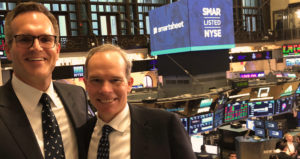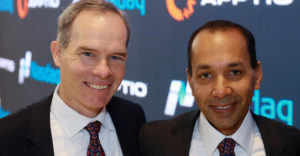Technology IPOs have rebounded the past couple of years with an especially strong start to 2018. In the first four months of 2018, there have already been 17 tech IPOs raising over $8 billion which is double the pace of 2017 in deals and capital raised. And, three companies founded in Seattle (Docusign, NLight and Smartsheet) all went public last week. At Madrona, we have had the privilege to support four portfolio company IPOs the past 2 years; Impinj, Apptio, Redfin, and Smartsheet. In every single case, we were involved at or near Day One and on average it took 12 years from our initial investment to IPO milestone.
When you invest in entrepreneurs and their companies from Day One, you build deep, trust-based relationships. You also learn some key insights that could help the next generation of innovators who are aspiring to build companies change the world. These insights include:
- Be obsessed with early customer-product fit
- Maintain “unreasonably high” expectations and standards
- Constantly look “around corners” to anticipate what needs to change
- Align for long-term and mutually beneficial strategies
- Establish and maintain deep, trust-based relationships
Be obsessed with early customer-product fit
Successful companies always begin with a maniacal focus on a core customer and problem. This initial focus is on customers and not “markets.” Markets often don’t exist yet when a team starts a company to solve a problem better than it could ever be solved before. And, the customers themselves take two general forms – the user and the buyer. Sometimes these two roles come in one person, but often in B2B businesses they are separate.
Today end users are increasingly empowered to find, try and adopt innovative new products. This bottoms-up adoption creates momentum for new solutions in both the consumer (Spotify, Redfin) and commercial (MongoDB, Smartsheet) worlds. Often these better solutions to real problems lead to customer adoption and early monetization. And, it is then that new channels in the consumer world or economic buyers in the commercial world emerge. But, it always starts with an end-user with a specific need (either explicit or latent) that can be better addressed with new products. The broader market or category for innovative products usually emerges later.
At Madrona, we find that you want to work with entrepreneurs who have high conviction about what the customer is hiring them to do. But, we also look for people who will hold their convictions “loosely in their hands” and willingly alter and shift their convictions as data and experience point to the need for changes in products, strategies or team members.

The Smartsheet team’s vision for a cloud collaboration platform for teams has been a constant, but it took two versions of the user interface to gain broad customer adoption. And, over a decade later, they are using machine learning, API integrations and workflows to continually improve how customers leverage Smartsheet.
Maintain unreasonably high expectations and standards
Entrepreneurs have a complex mix of personal attributes that often include substantial confidence and conviction combined with genuine humility and curiosity. Better yet, successful founders have a healthy dose of self-awareness of their strengths and weaknesses.
With these attributes as a foundation, it is possible to set unreasonably high expectations. High standards attract other talented people to be part of a team building truly breakthrough products and go-to-market models. And, high expectations motivate those talented people to do their best as individuals and as a team. This dynamic often creates a virtuous cycle of talent attracting talent, experiments that deliver iterative learnings, and ultimately the creation of market leading products that exceed customer expectations. Jeff Bezos summarized this dynamic well in his most recent Amazon Shareholder Letter.
The biggest risk to setting such aggressive standards and aspirations is when founders/executives don’t have sufficient humility and self-awareness to recognize their limits. These limits may be their personal development areas or the limits of those things they can’t directly control. These can produce internal dysfunction or cultural decay. Combining high standards and high self-awareness is often a path to success.
Constantly look “around corners” to anticipate what needs to change
One critical way to constantly calibrate which standards and expectations are reasonable is to look around corners and anticipate strategies, systems, structures and even functional leaders that need to change. Companies, and their leaders, are often better at introspection and adaptation when they face struggles. But, many of the very best performers are looking ahead, in the face of rapid growth, at how scale drives the need for adaptation.
Several years ago, Apptio founder and CEO Sunny Gupta identified that their strategic platform approach to cost transparency products would not enable them to predictably and

sustainably grow. He and his team developed a complimentary strategy to “appify” core customer use cases, including IT planning and financial management, and sell them to relatively smaller enterprise customers. Their enterprise applications strategy has meaningfully contributed to customer and revenue growth in recent years.
I think of the CEO role as really the Chief Alignment Officer. They are constantly looking out ahead toward the macro trends, market dynamics and internal constraints that need to be addressed. Often these forces are not going to show up in current operations in a clear way. CEOs need to find systematic ways, both quantitative and qualitative, to identify what is breaking (or will be breaking soon) and prioritize what must be fixed. Then, it is essential to align their teams, strategies and structures toward overcoming these challenges before it is too late.
Align for long-term and mutually beneficial strategies
Companies that focus on the long term are often internally aligned. And, of equal importance this clarity of objectives and goals helps produce external alignment. The best CEOs are seeking alignment externally with customers, partners, investors and more. They triangulate their own perspective along with internal and external viewpoints to make decisions. And, they look for mutually beneficial ways to win in the market.
While innovation can negatively impact outdated and legacy products and customers, finding alignment around a “growth mindset” can create a bigger pie of economic success. Satya Nadella has emphasized this mindset as CEO of Microsoft. He constantly encourages the company to be more customer and externally focused rather than competitor and internally focused. From a partnering perspective, this means actively working with game changing startups and balancing platform goals with the temptations to build products to that will compete with partners.
For startups this external alignment is crucial to long term company health and success. Entrepreneurs like Kabir Shahani of Amperity or Bob Muglia of Snowflake have identified a customer pain point and worked hard to align their product approach to meet this customer pain. They have also recognized the power of go-to-market partners such as Microsoft and AWS which provide core computing platforms for these global customers. These go-to-market partners can be extremely valuable for a startup, but it creates some inevitable tension between the platform and application provider. For start-ups, partner alignment becomes one of those key areas to be regularly assessing and looking “around corners” at what is on the horizon.
Establish and maintain deep, trust-based relationships
The mission of taking a Day One idea from improbable to inevitable is a daunting one. It is filled with mountaintop moments and times of doubt and discouragement. The reward, far beyond the financial benefits, is truly in the experiences and the people you get to travel the journey with together.
These relationships are built on respect, candor and integrity. They are best strengthened by how you handle the more challenging moments in a company’s life. When you miss a quarter. When you lose a key employee or customer. When you uncover unethical or self-centered behavior. When an external partner lets you down. When you must decide whether to sell or not to sell. There are many of these moments along the journey. And, nobody’s judgement or demeanor will be perfect. But, trying your best to do the right thing in the right way will strengthen the bonds of trust and respect with others. It is simply amazing how often those people who impress you most in challenging times become lifelong friends and professional colleagues.
Every journey from Day One to long run success is indeed a winding road. Customer obsession, high standards, looking around corners, long-term alignment and mutual trust are a powerful combination of attributes that I have found increase the potential for success along that path. Success has many dimensions including product success, customer success, team success and most importantly success in life. While an IPO is just a milestone along a bigger journey, it is a monumental one. It signals a coming of age for a team and a company that is ready to embrace new opportunities and expand their horizons. And, if a company is ready, current market dynamics are highly favorable for companies to access capital and leverage the benefits of being public. We look forward to helping to build more teams and companies that get to experience these great moments – and we hope you are on one of those teams!
Interested? [email protected]